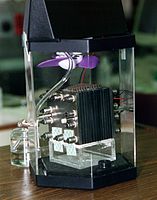
Photo from wikipedia
There is a need to understand the water dynamics of alkaline membrane fuel cells under various operating conditions to create electrodes that enable high performance and stable, long-term operation. Here… Click to show full abstract
There is a need to understand the water dynamics of alkaline membrane fuel cells under various operating conditions to create electrodes that enable high performance and stable, long-term operation. Here we show, via operando neutron imaging and operando micro X-ray computed tomography, visualizations of the spatial and temporal distribution of liquid water in operating cells. We provide direct evidence for liquid water accumulation at the anode, which causes severe ionomer swelling and performance loss, as well as cell dryout from undesirably low water content in the cathode. We observe that the operating conditions leading to the highest power density during polarization are not generally the conditions that allow for long-term stable operation. This observation leads to new catalyst layer designs and gas diffusion layers. This study reports alkaline membrane fuel cells that can be operated continuously for over 1000 h at 600 mA cm−2 with voltage decay rate of only 32-μV h−1 – the best-reported durability to date. Modern alkaline membrane fuel cells have generally shown very poor operational stability. Here, the authors combine operando neutron imaging and X-ray computed tomography to understand the root cause for this and then design new electrodes to enable high performance and operational stability.
Journal Title: Nature Communications
Year Published: 2020
Link to full text (if available)
Share on Social Media: Sign Up to like & get
recommendations!